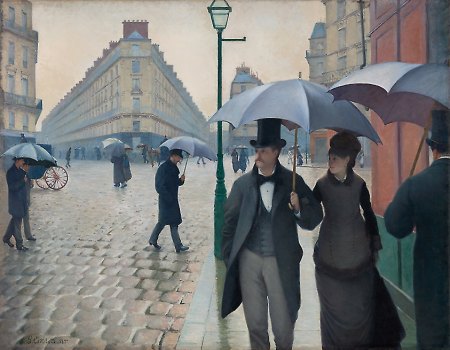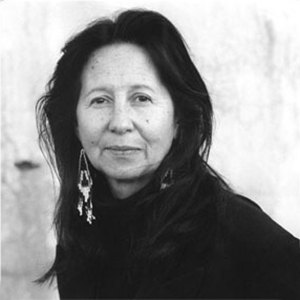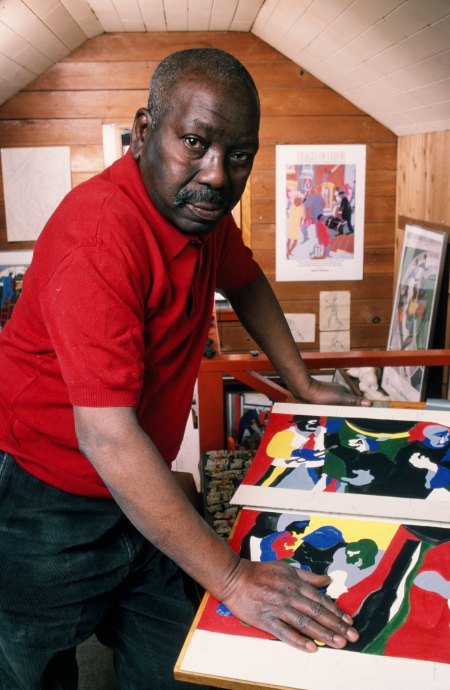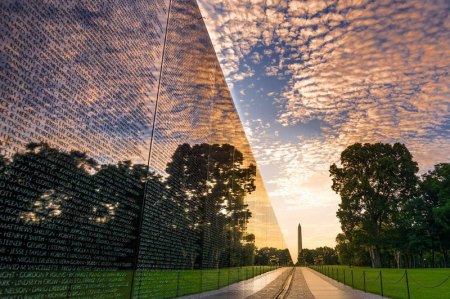Staff Picks
Art As a Way of Healing

07.07.21
It has been a difficult year to say the least.
Between the COVID-19 pandemic, and the recent mass shootings, at times, the world can seem like it is falling apart.
It can be hard to find the good in all of the dark and gloom.
In these extraordinary times, we all need something to hope for. We need something to comfort us and look forward to the future.
For me, art is that comfort, that hope for the future.
Gustave Caillebotte, Paris Street, Rainy Day (1877). Art Institute of Chicago, Charles H. and Mary F. S. Worcester Collection. This is one of my favorite paintings as I can easily imagine myself stepping inside and walking along on
the wet cobblestones.
One of the ways that art can help heal is that it can help us focus on living in the moment.
When a person looks at a landscape painting, they become transfixed by the bright colors and wispy brushstrokes.
The beauty of the trees and sky calms the mind.
Likewise, when you yourself are creating art, whether by stitching, painting, or sculpting, you are focusing on the task at hand and can quiet your thoughts.
Besides relaxing the mind, art can heal in other ways too.
Art can voice frustration at an unjust law, bring to light an overlooked problem, or to unify different groups of people.
Art, whether in painting, sculpture, photography, or writing, can seek to right injustices and bring people together.
Jaune Quick-to-See Smith
Her work conveys the suffering of Native peoples, while simeltaneously seeking a solution where people can come together.
Jacob Lawrence, an African American painter, sought to capture the great migration, where thousands of African Americans migrated to the northern states to flee the Jim Crow south.
While his paintings reflect the new life and hopes of African Americans in moving northward, they still show how racism existed even in the northern states and cities.
Jacob Lawrence
These artists seek to speak out against injustices while also being hopeful for a future resolution.
These two different artists exemplify that art is diverse and full of possibilities.
Which leads me to why I love art: because art is inclusive.
Art is open and welcoming to everyone. Art isn't restricted to any one medium; it comes in many shapes and forms.
From paintings and sculpture to film, photography, origami, and papercutting, there is something for everyone to enjoy.
And you don't have to be great at it! Art is not about talent and skill, but about feeling and understanding of one's self and others.
"So what does the library have to do with art? Aren't you just about books and movies?" you may ask.
Well, the library is full of art. But you may need some help in finding out just how much art we actually have.
The Vietnam Veterans Memorial in Washington D.C., designed by the architect Maya Lin in 1982. This monument, meant to symbolize a wound in the earth, acts as a reflection on the thousands who lost their lives in the Vietnam War. In this way, the monument seeks to heal the pain that the war caused.
You can find out more about these pieces by visiting the Art in the library page.
We also have many art pieces that you can check out and take home.
They are located in the northeast corner on the third floor. These pieces are great to spruce up a room!
Antsy for more artful ideas?
Visit Creativebug, a website that has thousands of art and craft demonstration videos; or try Overdrive and check out art and craft magazines.
Here are some of my personal recommendations from our collection to help you get started:
Art History
By Marilyn Stokstad and Michael Watt Cothren
Not your ordinary textbook, Stockstad's book on global art history is a great introduction for anyone new to art history. The chapters on non-western art are some of the highlights, shedding light on these oft-overlooked masterpieces. With its beautiful color pictures with easy to understand text, this is one of my favorite books to come back to.
Art: the Definitive Visual Guide
This massive book covers various art media from all over the globe. Organized chronogically, it details art from cave paintings to contemporary artworks. Hundreds of artists and thousands of art pieces are all at your fingertips.
My favorite part of this book is the special in-depth focus on specific pieces of art, where techniques and symbols are broken down and pointed out.
Treasures from the Art Institute of Chicago
By James Wood, Debra Mancoff, Laura Kozitka, and Catherine Steinmann
Unable to visit the Art Institute? No problem! View the highlights of the museum in this book.
The Beginner's Photography Guide
By Chris Gatcum
In this helpful book, readers are guided through the aspects of taking pictures. Topics range from which type of lens to use to the different ways light affects a photo's exposure. Full color pictures with handy diagrams and quick to find topics make this an excellent read for anyone interested in photography.
Hello Watercolor! Creative techniques and inspiring projects for the beginning artist
By Jeannie Dickson
A beautifully designed guide on beginning watercolor painting. The first half of the book is devoted to the different materials, techniques, and color definitions. The second half takes readers step-by step through fifteen different painting ideas.
I appreciate Dickson's step-by-step photos that help demonstrate how a technique is performed. They make the process that much more easy and enjoyable.
Beginner's Guide to Kirigami
By Ghylenn Descamps
Kirigami is a Japanese traditional art form that involves cutting and folding paper. I'm sure you may have seen it on greeting cards without even being aware of what it was called!
This book takes crafters through three sections, gradually increasing in difficulty, culminating in elaborate 3D cards.
Loving Vincent
This film is comprised totally of Vincent Van Gogh's paintings as they tell the life story of the gifted yet troubled artist. If you ever wanted to literally see a painting come to life, this is the movie for you!
Also available on Kanopy and Hoopla
The Story of Women & Art
Historian Amanda Vickery explores the various ways in which women have participated in the art world over the centuries. This three part series covers European women from about 1500-present.
Vickery does not limit her scope of discussion to the traditional art forms of painting and sculpture. Instead, she also takes a look at the role of women in fashion, interior decoration, craft making, and even garden design. Although a bit unconventional, this approach highlights just how diverse art can be, while demonstrating that women were active participants in various art forms.
Understanding Art: Baroque & Rococo
Waldemar Januszczak travels around Europe as he explores two art movements in this set of two previously separate series.
Waldemar is very down to earth and can be hilarious at times. He doesn't just focus on the artworks, but he attempts to explain the history and culture behind them. If you enjoy his presentation style, he has other series covering different art movements.
You can also view these series on Acorn TV through RBdigital.
Art 21 Seasons 1 & 2
In this acclaimed series, contemporary artists show their works. You will discover many artists that you never even knew existed!
Also available on Kanopy